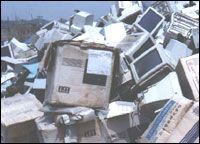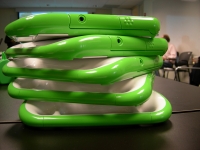I am Toon De Bruyn and while I am no expert on the OLPC project, nor on e-waste, but I try to develop my knowledge and skills on education for sustainability. After reading about the discussion that is going on the implementation of One Laptop Per Child, I have some questions on the environmental impact of this project.

Global e-waste
Increasingly, we are being swamped in spam and other junk email by the information age, but a more tangible effect is the increasing amount of e-waste.
The sheer volume and mass of discarded batteries, print cartridges, screens and other appliances which contain potentially harmful substances are becoming an environmental sticking point for producers, consumers of laptops and other appliances and for policy makers.
Discarded appliances pose a potential threat to our environment and One Laptop Per Child will represent a 10% increase in the total worldwide laptop production for 2007 and will be the largest single deployment of a computing platform ever. It is crucial to know how the production, use and dismantling of a high number of laptops should be dealt with.
From Seymour Papert's interview on USINFO we have this Question & Answer:
Q [Jean2]: What plan does OLPC have for recycling these $100 PCs after they break or become obsolete? It bothers me to think of the literally millions of non-biodegradable plastic PCs and their toxic parts languishing in landfills, leeching into groundwater, being picked over by children. Thank you.I must say this perspective really scares me! In fact, in my opinion, you cannot claim that you are "seriously concerned" about environmental issues when you do not try to understand the environmental impact of your project. The smart green color of the machine will not change this.A [Papert]: We're seriously worried about the environmental issues, but we cannot solve everything at once. It is better to have computers out there in the hand of the children, than to sit and worry about how to solve the disposal problem before they go there.
What will happen for instance with all those laptops after using them for 3 years (the average lifespan of laptops)? Who will be collecting and using taxes that may be levied for laptop disposal?
Are Children's Machine XO components easily recycled, either as parts of new machines or as source chemicals for new laptop construction? It may not contain hazardous materials and its NiMH batteries might not contain toxic heavy metals, but what about all that plastic?
The OLPC Wiki tells us that the machines are fully compliant with the European Union’s RoHS Directive. Still, these standards may not always be relevant for developing countries which often lack capacity to dispose of these products safely.
We learn from Ethan Zuckerman that I am not alone in my worries:
Joris Komen, director of Schoolnet Namibia, an award-winning educational computing project in southern Africa, asks in an open letter, "Will Nicholas’s laptops have the cost for ISO-14000+ compliant end-of-life recycling factored into their cost-price? This is an important consideration, given the fact that there are no ISO-14000+ compliant recycling plants anywhere in Africa."In addition, the human scale of the OLPC project is substantial. It will involve a high number of people of different age and educational backgrounds and with each different interest in the OLPC hardware.Komen goes on to note that his project spends $5 per machine they dispose of to ship the machine back to Europe so it can be correctly disposed of - to support disposal of the millions of laptops OLPC plans to distribute, the project team may need to work with governments to create recycling centers.
Therefore, developing environmental knowledge and policies will be both a challenge and an opportunity. The first step would be an environmental impact assessment of this project on different scales: globally, nationally and regionally.
Although making a strategic environmental impact assessment may increase the production costs and may make the implementation of this project even more complicated, the long-term benefits and positive repercussions will definitely contribute to the long-term sustainability of this project.
Developing nations requires a bigger commitment of policy makers and a high technical capacity. They harbor some of the last untouched natural resources, and the environmental consequences of unchecked e-waste would be devastating.
Therefore a strong framework is needed for the OLPC project's developers for the incorporation of environmental concerns into the whole life-cycle of this product. An environmental framework that is currently lacking.
I only wish this project will develop its environmental component to the fullest.



Toon De Bruyn, thank you for your focus at the environment. some thoughts to you and everybody else who happen to read this.. the environment again
we try to stop the western world dumping electronic waste in the poor countries but now we are instead selling it to them as a product for a short period of time before it brakes how fast do you think?
and then - what?
buy more? can they? where shall they get the money? and should they buy this additional ever growing pollution-problem?
can this project last longer than the payback-period from the first order, I wonder. new kids starts at school are they also going to learn to learn with olpc. do anyone believe that poor countries can make this a habit a method for years to come
add up what it would cost in any western country, your own – if you are lucky to live in wealth, and see if it would be quite easy to manage
western started with ICT in the universities off course and then we worked us the natural pedagogic way down among the young, the universities in the developing countries have some ICT now need, much more primer to this nothing or close to nothing of ICT
bridging the digital divide or more correctly get them up from the digital abyss is the task and at the same time do no harm to the environment
reuse of well functional products is common accepted as best for the environment. we can scale reusing our ICT – it's easy – we now how, including our take-back system for EE-waste. need I say more ?
www.fairinternational.org
Having followed Papert's work for a good portion of my life, it was definitely disheartening to read his comments regarding the environment. My biggest concern with the OLPC initiative has the been environmental impact of these machines from manufacturing to disposal. There is no cohesive well thought out "plan" by these folks and it is very discouraging. I am hoping that if enough people apply pressure we can get answers....
Great news on OLPC recycling & end of life issues:
Yes - we are developing out take-back policy right now - and plan for no laptop to end up in landfills - anywhere. This is actually part of the EPEAT/ IEEE 1680 specification for environmental laptop and desktop design. We believe that we will be the first laptop to ever achieve EPEAT Gold rating - we are
Mary Lou Jepsen on OLPC Open Requests: http://mailman.laptop.org/pipermail/olpc-open/2007-May/000180.html
FYI From the OLPC wiki:
http://wiki.laptop.org/go/Environmental_Impact
"The OLPC recycling take-back program: For an additional $0.10 per laptop Quanta believes that they could institute a full take back recycling program. We are fully assessing the exact cost but are planning a full take back program to be implemented in each country."
Please don't flame me here -- I am just reproducing what I read on the wiki.